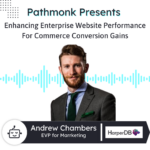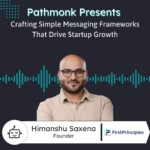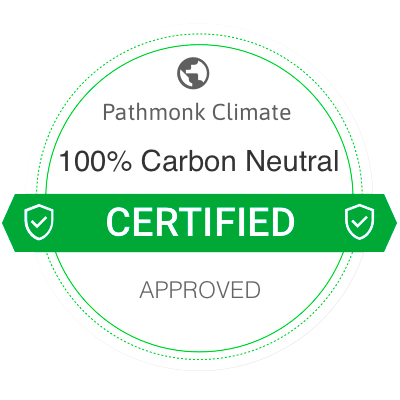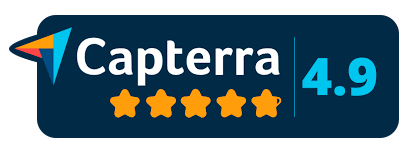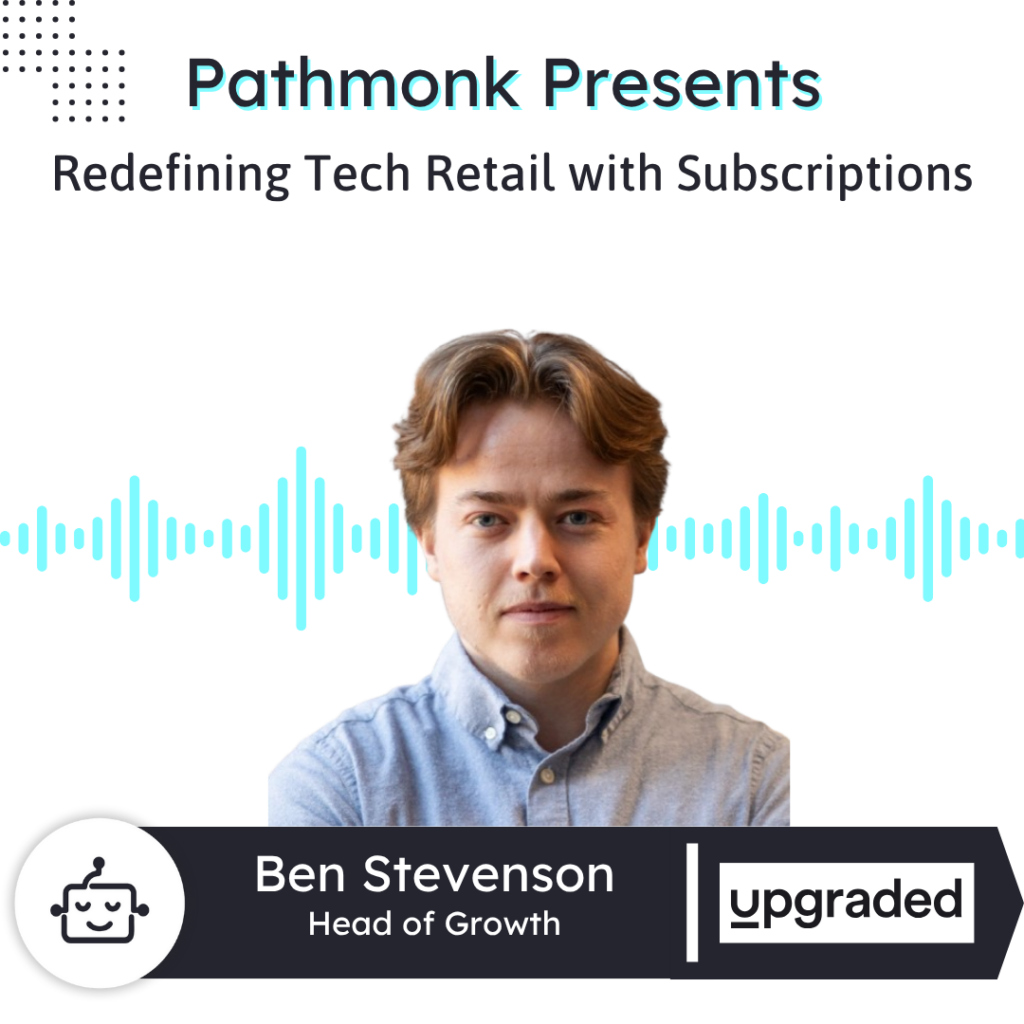
Introduction
Join us on Pathmonk Presents with Ben Stevenson, Head of Growth at Upgraded, an innovative online electronics retailer. Ben shares how Upgraded’s MacBook subscription program offers affordable upgrades for designers and developers while reducing e-waste.
Discover strategies for leveraging paid marketing, aligning website branding with Apple’s aesthetic, and addressing customer objections to boost conversions. Learn tips for using analytics tools like PostHog and user testing to optimize e-commerce flows.
Tune in for actionable insights to create seamless customer experiences and build a sustainable tech retail brand!
Increase +180%
leads
demos
sales
bookings
from your website with AI
Get more conversions from your existing website traffic delivering personalized experiences.

Rick: Pathmonk is the AI for website conversions. With increasing online competition, over 98% of website visitors don’t convert. The ability to successfully show your value proposition and support visitors in the buying journey separates you from the competition online. Pathmonk qualifies and converts leads on your website by figuring out where they are in the buying journey and influencing them in key decision moments with relevant micro experiences like case studies, intro videos, and much more. Stay relevant to your visitors and increase conversions by 50% by adding Pathmonk to your website in seconds, letting the artificial intelligence do all the work and increase conversions by 50% while you keep doing marketing as usual. Check us out on Pathmonk.com.
Alright everyone, welcome to today’s episode of Pathmonk Presents. Today we are joined by Ben Stevenson. He’s the head of growth at Upgraded. Ben, welcome to the show.
Ben Stevenson: Thank you. Thank you, Rick. Thanks for having me.
Rick: Of course. Excited for this conversation. To start, I want to start with the basics. Ben, what’s the big idea behind Upgraded, and if you were to explain it to a friend over coffee, how would you describe what you do?
Ben Stevenson: Long term, I would say that we are building the best electronics retailer in the world—all online. You look at companies like Best Buy, it’s a $14 billion company, but no one really likes it. And so we think there’s a lot of room for improvement there, especially one that allows for more refurbished devices that are better for the environment, so not as much waste is ending up in landfills every year.
What that looks like right now is a MacBook upgrade program where, say, you want to buy a new MacBook but you don’t want to pay $3,000 upfront. With us, you can spread that cost out over 36 months from 0% interest. So you’re just paying like a low monthly subscription essentially. And then if you want, you can upgrade every 24 months to the latest model. So we have a lot of customers who are designers or developers or editors who want to have the latest device, want an affordable way to get it, but there’s just nothing really good out there yet. They don’t want to have to deal with reselling stuff on Facebook Marketplace, so we make it super simple for them.
Rick: Got it. Okay. What kind of customer do you think is the best fit for that type of product? Because I’m thinking—obviously I have a MacBook myself, right? And I do love an upgrade, don’t get me wrong. Is there a specific type of customer that you’re targeting for this right now? Or maybe across the industry, is there a key problem that you think you’re solving for them and how does that impact their shopping experience? I’d be curious to know.
Ben Stevenson: I would say there’s mainly two. The first one is what I mentioned, which is people who use their laptop or their MacBook for work and who really depend on it for speed and efficiency. Maybe it’s making them money because they’re a freelancer or something like that. So anyone who’s a developer or designer or a video editor, a photographer—people like that. It’s like you have to have the latest device, otherwise you’re just wasting a bunch of time sitting around waiting for things to load. And so for those people, we make it affordable and make the upgrade process really simple.
Whereas before, you’d have to always be reselling a device on Facebook Marketplace or eBay or whatever, and it becomes a hassle. The second one is people who just want a more affordable way to buy a MacBook—especially those with a good credit score where they would qualify for the 0% interest. Because you don’t have to upgrade every two years if you don’t want to. You could just finish paying it off over 36 months and then it’s yours to keep forever. So we have a lot of people who are just like, “Oh, I can get this for 0% interest and pay over 36 months instead of upfront? That’s a no-brainer.” And then oftentimes people stick that extra money into a high-yield savings account or something like that and just earn interest on the money they otherwise would’ve spent.
So I would say those are the two main people that we target.
Rick: Yeah, makes sense. Makes sense. How do most of them discover you? Are there any channels that have become your go-to for bringing in your customers? In a way, you’d be presenting yourself as a financing option of sorts, right? But what kind of channels are you using the most right now?
Ben Stevenson: Right now it’s mainly split. The majority is paid marketing, which is mostly Facebook ads and Google ads. We do a little bit of Reddit and X as well. And then one other thing that’s worked well for us is sponsored posts on some of these tech or Apple news sites—like Apple Insider, 9to5Mac, Cult of Mac, things like that—where it’s people who are already in the Apple ecosystem. They love learning about this stuff, and then we just get in front of them that way.
We’re also working to do a lot more organic content creation. We started a YouTube channel in the past two months that’s starting to grow well and things like that. Because that’s the long-term vision—to build a whole media empire, a media arm side of this that helps educate and teach people about tech and buying tech and all that sort of stuff.
Rick: I would assume that kind of involves unboxing, tech reviews, and things like that?
Ben Stevenson: Yep, exactly. All of that stuff—productivity tips, more lifestyle content. We’ll do it all. It’s all in the early stages of growing.
Rick: Makes sense. Obviously, I talked about Pathmonk in the intro here—it’s a website tool—so a question about the website itself has to slip in. How much of a role does your website play in pulling in new customers? And more than anything, I would love to understand if there’s anything about it that you think really works right now or, on the other hand, anything you’ve got your eye on improving.
Ben Stevenson: Yeah. I would say for us, the website is mostly a bottom-of-funnel conversion metric. We don’t do a lot of content within the website that brings people in—we don’t have a large blog or article presence that is SEO-driven, where people are finding us through that. It’s mainly just for purchasing.
And so that’s where we look a lot more at just, how do we increase conversion rates? One thing we’ve learned is that the website is an extension of your brand. How the website comes across indicates to people how they should perceive your brand. For us, we try to model ourselves a little bit after Apple because Apple is a luxury product—but also one that many people have. You don’t have to have a ton of money to buy an Apple product. It’s not like a Birkin bag or something like that.
It feels very nice and clean and modern. So we try to build our website like that so that people get that feeling as they’re coming through the flow, and it feels very trustworthy—like, “Okay, this kind of feels familiar to me.” It’s not like you’re claiming one thing in your ads and then your website experience doesn’t match that at all.
Another one for us is just making sure that you explain everything extremely clearly—especially in a way that makes sense to people who don’t use the jargon or know the technical terms of your business. I think a lot of times all marketers, especially tech-focused people, are so used to these terms because we spend every day working with them. So you know about the different APRs and the financing options and hard vs. soft credit checks. But a lot of people don’t think about that stuff—and might not even know what some of these terms mean.
So how can you translate the technical stuff into everyday language anyone can understand as they’re coming to the website? Make it as simple as possible so people don’t have questions. That’s a big one. For that, it’s hard to beat user testing. You can use some of these sites that will pay people to go through your checkout flow and narrate their experience.
All of that has been part of our process—how we think about it. I think long-term, we do want to add more organic content or an SEO presence so we’re giving people everything they would need on the website—not just a place to check out.
Rick: A note on your first point about branding—your website looking like Apple. In fact, when I was researching before we got to recording today, I visited getupgraded.com and as soon as I opened it, I thought, “Hey, hold on, is this Apple.com?” I double-checked the URL. I think it makes sense from a brand standpoint—to have that seamless look and feel. “Oh, is it Apple? No, it’s not, but it looks like it.” That makes a lot of sense.
From your perspective as head of growth, besides branding and being strategic with the placement of elements, what are the key components of a high-converting e-commerce site for you? And if you have any tools or strategies you rely on to boost sales, feel free to share—our listeners will love it.
Ben Stevenson: Yeah, absolutely. I think of it from every stage of the funnel and the buying journey. For us, a lot of the focus is on: How are we presenting the information initially to customers? So when they see the first Facebook ad or Google ad, we make sure all the information is clear, portrays the offer well, and makes sense.
After that, the biggest thing is making sure the website and flow match their expectations. Based on what they saw before—do they land on a site that feels like what they were hoping for?
Another thing, especially with us, is thinking through all of the questions or objections people will have as they go through the website. Especially questions like, “How do you guys make money?” or “How does this work for you?”—answering those can go a long way. Especially when you have a product that almost seems too good to be true.
That’s one thing we dealt with early on—a lot of people asking, “How do you offer 0% interest? How are you making money? Is this a scam?” So we tried to do a lot on our website to show exact breakdowns. For example, we say, “When you’re buying this laptop, it’s $999 for this model, then there’s AppleCare which adds $179, and then we divide that by 36—that’s your monthly payment.” So users see there are no hidden fees. It’s just the same price divided by 36.
We also explain how we make money—talking about our margins—so people get that it’s legit. That doesn’t apply to every company, but I think most customers do have questions. And it’s your job to think of them before they get there and address them.
Analytics is key. Everyone says that, but we use PostHog, which is a pretty detailed analytics tool to look at where people are coming from, how long they’re staying, session recordings, and so on.
We’ve also used sites like usertesting.com to pay people to go through the flow and narrate their experience.
The only other one I’d add is: make sure you’re listening to customer feedback however you can. In e-commerce especially, it’s easy to lose that touchpoint. We maintain a presence on Reddit, monitor what people are saying about us, read every Facebook ad comment, every YouTube comment—and use that feedback. Some people ignore it, but it’s to their detriment. If your customers are giving you feedback, take it and apply it to your site.
Rick: Totally. The whole thing is about being able to listen to your customers. That’s the way I understand it, and I like the point about preemptively eliminating objections with the copy itself and the website itself, so that people go through, have a question in mind—and boom, there it is, answered. It gives confidence—like, “You clearly know what you’re doing.” It’s like a back-and-forth that doesn’t exist—it’s only the person and the website.
So that’s a great point for converting. Definitely one of the best answers so far.
Ben Stevenson: Yeah. It kind of reminds me—this is slightly different—but of when you’re designing a product. There’s the famous Henry Ford quote about building a product people don’t even know they want yet. He said, “If I asked customers what they wanted, they would’ve said faster horses,” right?
But instead, if you can build the car and present that to them, people go, “Oh, this is way better.” So you should be thinking about that when you’re building the website—how can I deliver the value people didn’t even know they wanted yet? They’re going to have questions lingering in their mind, so how can I put the answer in front of them before they even get there?
Rick: Good one. Let’s keep it at that level of thinking for a moment—I want to understand a bit more about how you think. I want to shift gears a bit and talk about you as a leader. As Head of Growth, what’s your daily life like? Whether it’s your typical workday or your main focus areas, that would be helpful for our listeners—and for myself too.
Ben Stevenson: The way I try to think about it—and obviously this is hard to do—is split between long-term strategic thinking and day-to-day getting stuff done.
Especially at our company, we’re a pretty small team, so I’m hands-on keyboard, doing pretty much all of the work that needs to be done when it comes to growth stuff.
Tactically, day-to-day, it’s a lot of thinking week by week: What’s the plan for this week? Okay, we have some sponsored posts going out—I need to write those, draft the first versions, and send them to the websites. That’s one. We’re trying to come up with some new video ads, so I’m writing scripts. We’ll film them on Thursday, say. There’s that. We’re doing check-ins on how our ads are performing—do we need to make tweaks? Are there things that need to be moved around? I make all those decisions.
So there’s a lot of tactical stuff like that. One thing I really like about our company—and something we try to maintain—is that we don’t have too many meetings. It’s a lot of deep focused work time where you can really get into something.
I’ve previously worked at a marketing agency where that wasn’t the case. I don’t know if you’ve ever had one of those days where you’ve got a zebra calendar—30-minute meeting, 30-minute work, 30-minute meeting again—it’s just very hard to get things done. So we try to leave big blocks of time for focused work.
Then, for me, the more fun part is long-term strategic thinking—what do we need to be doing now to win in this space? What strategies are out there that we’re not seeing yet?
Right now, there’s a lot of interesting stuff around content creation and AI. Those are the two big areas we’re thinking about. I think more companies are winning just based on content creation. Duolingo is a great example. They have all sorts of marketing channels, but their organic content crushes on TikTok and Reels. So they’ve found a method that works.
There are also smaller entrepreneurs—like real estate agents—who are crushing it on social media. There are ways to make that work. So how can we find what will work for us? What’s the new stuff to explore?
Then we run little tests to see if something can work. Same thing with AI—what are people doing? How are they using it for marketing? Can we use it to create ads, scripts?
We’re figuring out where it actually works—like, where we can basically outsource tasks to AI—and where it still needs some work. For example, video generation: it’s good at generating videos, but to turn those into actual ads? It’s not quite there. The hands are messed up, fingers look off—it doesn’t quite look real yet.
But we’re keeping a pulse on that so that when it does get good enough, we can start integrating it into our work.
Rick: That’s good—especially now with all the AI agents people are coming up with and automations… it’s just getting crazy.
But your point about AI-generated videos becoming more realistic—I agree. We’re getting there. You can see the progress day by day. People post both the good and the not-so-good examples. It’s not quite there yet, but it’s helping—maybe by speeding up processes or helping ideate.
Okay, cool. So before we wrap things up, Ben, we typically have a rapid-fire segment. The only unspoken rule—and I guess I’m speaking it now—is that for a concise question, we want a concise answer. Would you be ready for that?
Ben Stevenson: Okay. I’d be ready for that.
Rick: Watching or reading?
Ben Stevenson: Reading.
Rick: What’s the latest book or article that you picked up, and are there any gems or ideas that really stuck with you?
Ben Stevenson: I’ll give you two. Book-wise: I read the book from the YouTube channel Yes Theory. I’m not sure if you’re familiar with them, but they’re very popular. Great founding story—super interesting book. It’s a biography.
Article-wise: there’s one from a VC firm called NFX. The article’s titled “I Think You’re Living on Network Effects.” It’s a banger article, I’ll say that. It explains how the network you’re in impacts your life to a very great degree. That one got me thinking in a different way.
Rick: Love that as an insight. Have you ever watched The Buried Life?
Ben Stevenson: I have not. But Yes Theory and them are very similar—they work together. Yes Theory was inspired by that.
Rick: Yeah, it was a great show. I loved it.
Okay, cool. So if you had a magic wand and could fix one frustrating thing in your marketing life with tech, what would it be?
Ben Stevenson: Automation of video editing. We’re doing a lot of video filming, but the editing still has to be outsourced. It’d be great if we could automate that with AI.
Rick: Yeah. That’s a good one. Typically it’s that and emails—those are the usual picks.
Alright, Ben. If you could go back and give your past self a quick pep talk right at the start of your marketing journey, what advice would you drop?
Ben Stevenson: Get around way more people who are actually doing marketing right now. There’s a lot of great advice online—you shouldn’t ignore that—but especially in marketing and with AI, things move so quickly.
It’s really helpful to talk to people who are marketing at other companies. Recently I’ve started hopping on more calls with people like that, and it’s so helpful to see: “Oh, this is what we tried last week and it’s working.” Or “Here’s how we’re using TikTok and having a team of creators make content—and it’s working.” That’s super helpful. I think you get so much value just talking face-to-face with another person. There are sites now where you can just sign up to do that.
Rick: It’s about that connection and keeping it in context—learning from others. That’s really good.
Ben Stevenson: Yeah. 100%.
Rick: Ben, I want to thank you a lot for being on the show with us today. And I want to give you the last word. So if someone forgets everything about today’s interview, what is the one thing they should remember about the work you guys are doing at Upgraded?
Ben Stevenson: I think they should watch the growth and look for us as a new company on the horizon. But I think it’s not really about us—it’s more about their own journey. I think the more important thing is about learning. And like I just said, surround yourself with other people who are doing the things you want to do, and you’ll learn and grow from that. We’re trying to do the same thing—and we’ll keep going on our journey as well.
Rick: Love it. Love it. So Ben, if anyone wants to check you guys out and maybe needs to upgrade their MacBook right now, where should they go?
Ben Stevenson: Best place is the website: getupgraded.com. It seriously is the best way to buy a MacBook. So if you’re looking for that sort of thing, do that.
Otherwise, our YouTube channel—if you just search “Upgraded” on YouTube—you should be able to find it. There’s some good videos there as well.
Rick: Perfect. Alright, we’ll send people there as much as we can. Awesome. Thanks for being with us, Ben, again—and we’ll see you hopefully again soon before the end of the year.
Ben Stevenson: Yeah, this was great. Thank you.
Rick: Alright. Thank you. Bye everyone.




